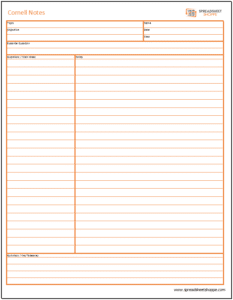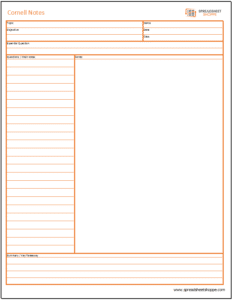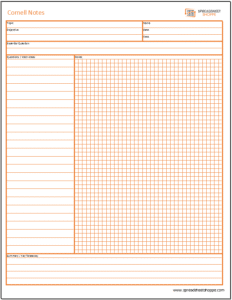Whenever I follow a process or implement a system, I’m more successful.
The Cornell Note taking system is just that. A formal process that can easily be implemented. It’s a structured note taking process. But, really its much more.
The Cornell Note-Taking System also provides a study and review method. Taking you from lecture to test. Hopefully, with successful results.
Cornell Notes Templates
System Requirements & General
Cornell Notes Download
Download 52.89 KB 6464 downloadsCornell Notes – Getting Started
- Download the template. You can download this free excel template by clicking the download link above. All 3 options shown are included in the download.
- Select the template that best fits your needs.
- Print off several sheets and take them to your next lecture/class/meeting.
Cornell Notes – The Process
- Take Notes – The note-taking column is the largest section of the page. Your sentences should be short. Telegraphic sentences are typically 5 words or less. They’re simple, yet concise. Use your space wisely.
- Questions / Main Ideas – Next to the notes section is a location to capture the main ideas. You can also use this space to write questions about the information you just received. Do this as soon as possible. This is the first step in solidifying the concepts, and it kicks off the rest of the Cornell process.
- Summarize – At the bottom of the sheet is a section to summarize the concept. This should focus on the overall key concept.
- Study Step 1 – Cover up the notes and summary. Then, using the questions / main ideas column, describe the concepts / information using your own words. Say it out loud.
- Study Step 2 – Ask yourself questions about the concepts / information. These questions should be broad and allow you to reflect on the information at a high level. For example: “What was the most interesting or surprising information?” “How does this relate to what I already know?” “How would I explain this to a 7 year old?” “What are the fundamental principals?” “How could I implement this?”
- Study Step 3 – Every week, spend time (suggest 10 minutes) going back over previous notes, questions, and summary information. Look for links between the items. If you’re working toward a test, do this right up to the testing day.
Additional Ideas
Information that is surprising or shocking is more easily retained.
Look for ways to make the content you’re going over surprising and shocking. It will stick if you can.
Also, it’s very important to link information to other knowledge you already have. These connections are best if they’re direct. However, you can always relate one concept to another.
For example, lets say you understand sports. Maybe you play (or played) a sport and understand the fundamentals of practicing, strategy, and general preparedness. The more effort that is put into those buckets, the better the result, generally. The same concept can be applied to study.
It’s possible to draw these connections to more specific concepts as well. Someone who is just learning Excel may know how to use a formula to add up certain cells “=A1+A2+A3”. They know this gives them the sum of those 3 cells. When the formula “=Sum()” is presented as a new concept, they should relate it to what they already know. =Sum(A1:A3) is the same as =A1+A2+A3.
Granted my examples are very basic, but the point stands. The better you can relate new information to what you already know, the better you’ll truly understand.
Resources
If you want to watch a youtube video on this process. This video is a little over 5 minutes and has good ratings.
Here’s an example of Cornell Notes in practice along with a good write-up.
Interested in other note taking options? Wikipedia has you covered.


